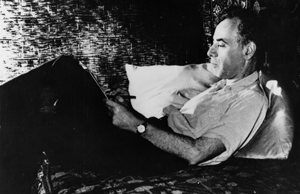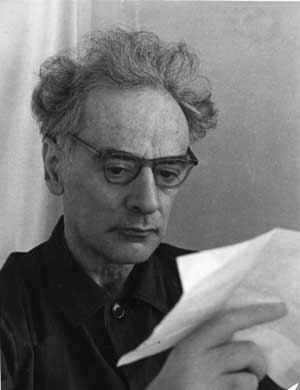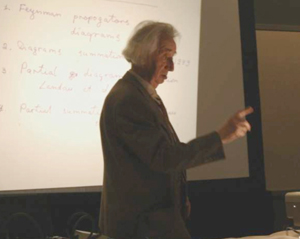Centenary of Lev Landau
By Gloria B. Lubkin, Forum Chair
The Forum commemorated the "Centenary of Lev Landau" in an invited session on Wednesday morning, March 19. Four of the five speakers had worked with him. They discussed his achievements and their personal interactions with him. All five emphasized Landau's impact on theoretical physics over much of the 20th century. An enthusiastic audience overflowed a lecture hall with 300 seats. Many listeners stood in the back of the room for three hours, while others waited outside the doors until they could slip in.

Credit: AIP Emilio Segré Visual Archives, Physics Today Collection.
Lev Landau
The first speaker, Pierre Hohenberg (NYU), was the only one who had not worked with Landau. His talk, "Lev Landau: A View from the West," gave an overview of Landau's main scientific achievements. For Landau's 50th birthday, he was presented tablets with the "Ten Commandments" to represent his ten greatest papers: These were: density matrix (1927); Landau diamagnetism (1930); dynamics of ferromagnets (1935, written with Evgenii Lifshitz); theory of phase transitions (1937); intermediate state of superconductors (1937); statistical theory of nuclei (1937); theory of superfluidity (1941); renormalization of electron charge in quantum electrodynamics (1954, with Alexei Abrikosov and Isaac Khalatnikov); theory of Fermi Liquid (1956); and two-component neutrino theory (1957). Members of the famed "Landau school" of physics extended his influence. He also had a great impact on 20th century physics through the ten volumes of The Course of Theoretical Physics, by Landau and Lifshitz (after 1962, with Lev Pitaevskii and V. B. Berestetsky).
Even more significant, Hohenberg said, is Landau's pervasive influence on many major theoretical advances in condensed matter and statistical physics during the second half of the 20th century. Some of these developments can be viewed as "elaborations, advances and, yes, corrections to the foundational theories and points of view" that Landau had initiated. One example is the theory of superfluidity in Bose liquids, in which he resisted the explanation in terms of Bose condensation that had been introduced by Fritz London and László Tisza. Another example is the theory of second - order phase transitions, which laid the foundation of the study of critical phenomena using the renormalization group.
Lev Pitaevskii (University of Trento and Kapitsa Institute for Physical Problems) spoke on "Landau and Theory of Quantum Liquids." He concentrated on Landau's most famous contributions - the theory of superfluidity and the theory of quantum liquids. "Superfluidity literally saved his life," Pitaevskii said. After Landau's arrest in 1938, Peter Kapitsa wrote to Stalin asking for his release, but to no avail. A year later he wrote to Vyacheslav Molotov, then the nominal head of the government, telling him that "during work on liquid helium, at temperatures near absolute zero, I have been able to discover a number of new phenomena which can clear up one of the most puzzling areas in modern physics." To understand the phenomena he would need Landau's help, "but he has been under arrest a year now." The second plea led to his release. Landau later told Pitaevskii that just before he was released, he had felt that he would die in another week or two.

Credit: AIP Emilio Segré Visual Archives, Physics Today Collection.
Lev Landau
Valery Pokrovsky (Texas A&M University and Landau Institute) spoke about "Landau and the Theory of Phase Transitions." When Pokrovsky first met Landau, he observed that he "was very tall, almost one-dimensional, with a very bright and penetrating gaze. He was extremely fast with a deep understanding." Landau was very influential but not a revolutionary like Niels Bohr or Albert Einstein. To evaluate his influence, Pokrovsky used the Scirus 2008 database of scientific citations. His work on Fermi liquids had 45,000 citations, phase transitions 30,000, Landau levels 75,500, and the Landau-Lifshitz equation 23,000. Five Nobel prizes derived from Landau's work, awarded to Kenneth Wilson; Klaus von Klitzing; Pierre-Gilles de Gennes; Daniel Tsui, Horst Störmer, and Robert Laughlin; and Alexei Abrikosov, Vitaly Ginzburg, and Anthony Leggett. And the Landau-Lifshitz Course has had unprecedented longevity, from 1940 until today.
According to Pokrovsky, Landau's approach to theory was characterized by three features: (1) extremely general, simple notions, such as the density matrix, spontaneous symmetry breaking, Fermi liquids, and quasiparticles; (2) a simple, effective formalism, e.g., in phase transitions, Landau levels, and neutron stars; and (3) a comprehensive view of all of physics. Landau formulated his theory of phase transitions in three 1937 articles. They introduced the order parameter as a measure of symmetry violation and showed how it appears spontaneously within the framework of the mean-field approximation. In the early 1940s, Lars Onsager published his solution of the two-dimensional Ising model, disagreeing with Landau, who then doubted his own theory was applicable at all until A. P. Levanyuk and Ginzburg showed the mean-field approximation to be invalid near phase transitions.

Photo by George Zimmerman
Igor Dzyaloshinskii at the Landau Centenary session.
Igor Dzyaloshinskii (University of California, Irvine) discussed "Landau and Feynman Diagrams." In the latter part of the 20th century, these diagrams dominated theoretical physics. "Feynman introduced an alternative to symbols and used a visual presentation instead," said Dzyaloshinskii. Landau regarded Feynman diagrams and Freeman Dyson's concept of their visual summation as breakthroughs in the physics of particles. In his intuitive way, Landau introduced the concept of partial-summation, which led to major results in particle physics and condensed-matter theory.
Dzyaloshinskii traced some major developments in condensed-matter theory by members of the Landau school, growing out of Landau's partial summation ideas. These included: the discovery by Landau, Abrikosov, and Khalatnikov of the connections between bare charge and renormalized charge and between bare mass and renormalized electron mass; the application by Arkady Migdal and others of Feynman diagrams to Fermi and Bose gases; Landau's development of the theory of Fermi liquids; and a Feynman diagram approach to the BCS theory of superconductivity developed by Led P. Gorkov.
The last speaker was Roald Sagdeev (University of Maryland), who spoke on "Landau's Contributions to Applied Physics." He quoted from Lifshitz's preface to their volume on hydrodynamics: "Here Landau has brought part of his soul. He was fascinated by this area of theoretical physics. He started to derive and rethink all of its key results." During World War II, Landau worked on a strong shock wave spherically imploding and converging to the center. In the paper, Landau noted that he wasn't considering what caused the shock wave, just what happens next. Later he introduced the concept of evolutionary behavior and what behaviors need to be excluded as unphysical. He gave credit to others who had contributed to the field, including Leonid Sedov, who had organized a campaign against one of Landau's adopted pupils, Yakov Zel'dovich. When the Soviet Union launched the first artificial satellite in 1957, the program was highly classified, so nobody knew who was responsible for the satellite's success. In public statements, the government gave credit to Sedov. Years later Zel'dovich was asked why he hadn't worked on Sputnik. In his reply Zel'dovich finally retaliated, saying, "When you eat a nice dinner in a restaurant, you thank the waiter, not the cook."
Sagdeev remarked that the hydrodynamics volume of Landau and Lifshitz introduced the special language of theoretical physics. In areas such as turbulence you can't get much from first principles, so Landau used a semi-empirical approach for concepts such as mixing length, viscosity, and heat conductivity (especially in boundary layers). Landau's first major contribution to plasma physics came before the war. He simplified the collision integral in the Boltzmann equation as applied to plasmas. And in 1956 he introduced the idea of Landau damping in collisionless plasma.
When Sagdeev was still a student at Moscow State University, Landau wanted to see the recently built skyscraper that was the university's new home. During the visit, Sagdeev met Landau and asked if he could become his student. "If you pass my exams, you can be my student, even if you're a criminal," Landau replied. After he passed the theoretical minimum, he was faced with a Soviet government decree that all theoretical physics graduates of Moscow University were to be sent to a new nuclear weapons lab in the Urals. But Landau persuaded Igor Kurchatov to bring Sagdeev to his own atomic energy institute in Moscow. In that way, Sagdeev worked at Kurchatov's institute 80 percent of the time and could attend Landau's seminar the rest of the time.
*An article on Anderson Localization, the topic of the third FHP invited session of the 2009 March Meeting, will appear in the Spring 2010 Newsletter.
Note Added: This article represents the views of the author, which are not necessarily those of the FHP or APS.
